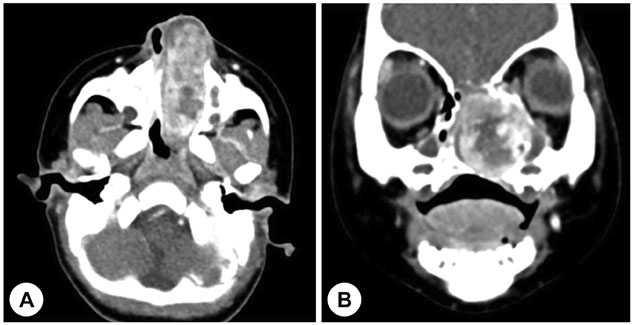J Rhinol.
2017 Nov;24(2):127-131. 10.18787/jr.2017.24.2.127.
A Case of 2-Month-Old Infant with Lobular Capillary Hemangioma
- Affiliations
-
- 1Department of Otorhinolaryngology, Seoul National University College of Medicine, Seoul, Korea. handh@snu.ac.kr
- KMID: 2398832
- DOI: http://doi.org/10.18787/jr.2017.24.2.127
Abstract
- Lobular capillary hemangioma (LCH) in the nasal cavity, previously known as pyogenic granuloma, is an extremely rare benign vascular tumor in infants. LCH is a rapidly growing lesion that has a bleeding tendency due to its excessive vascularity. The authors experienced a case of LCH of the nasal cavity in a 2-month-old infant that was totally resected via the endoscopic approach after preoperative embolization. Therefore, we report this case with a brief review of the literature.
MeSH Terms
Figure
Reference
-
1. Mills SE, Cooper PH, Fechner RE. Lobular capillary hemangioma: the underlying lesion of pyogenic granuloma. A study of 73 cases from the oral and nasal mucous membranes. Am J Surg Pathol. 1980; 4(5):470–479.2. el-Sayed Y, al-Serhani A. Lobular capillary haemangioma (pyogenic granuloma) of the nose. J Laryngol Otol. 1997; 111(10):941–945.
Article3. Lee JY, Koh ES. A case of cavernous hemangioma originating from the posterior end of inferior turbinate misdiagnosed as the nasopharyngeal anagiofibroma. J Rhinol. 2007; 14(1):60–64.4. Kim NY, Choi SM, Kim CH. Lobular capillary hemangioma (Pyogenic Granuloma). Korean J Otolaryngol-Head Neck Surg. 1994; 37(6):1293–1297.5. van Vugt LJ, van der Vleuten CJM, Flucke U, Blokx WAM. The utility of GLUT1 as a diagnostic marker in cutaneous vascular anomalies: A review of literature and recommendations for daily practice. Pathol Res Pract. 2017; 213(6):591–597.
Article6. Park SK, Cho HW, Jang SH, Park CK. Clinical study of lobular capillary hemangioma in nasal cavity. Korean J Otolaryngol-Head Neck Surg. 2000; 43(4):402–405.7. Lance E, Schatz C, Nach R, Thomas P. Pyogenic granuloma gravidarum of the nasal fossa: CT features. J Comput Assist Tomogr. 1992; 16(4):663–664.8. Kim KJ, Kim TY, Kim YH, Jang TY. A case of giant nasal lobular capillary hemangioma during pregnancy. J Rhinol. 2011; 18(2):142–145.9. Leyden JJ, Master GH. Oral cavity pyogenic granuloma. Arch Dermatol. 1973; 108(2):226–228.
Article10. Park MJ, Ko B, Han EM, Sohn JH. A case of multiple lobular capillary hemangiomas of the nasal septum. Korean J Otorhinolaryngol-Head Neck Surg. 2015; 58(6):421–424.
Article11. Katori H, Tsukuda M. Lobular capillary hemangioma of the nasal cavity in child. Auris Nasus Larynx. 2005; 32(2):185–188.
Article12. Kim JH, Park SW, Kim SC, Lim MK, Jang TY, Kim YJ, et al. Computed tomography and magnetic resonance imaging findings of nasal cavity hemangiomas according to histological type. Korean J Radiol. 2015; 16(3):566–574.
Article13. Chang DS, Choi MS, Lee HY, Cho CS, Park SG, Park NS, et al. Clinical study of the intranasal hemangioma. Korean J Otorhinolaryngol-Head Neck Surg. 2015; 58(5):324–329.
Article
- Full Text Links
- Actions
-
Cited
- CITED
-
- Close
- Share
- Similar articles
-
- A Rare Case of Synchronous Pleomorphic Adenoma and Lobular Capillary Hemangioma of Nasal Septum
- A Case of Concurrent Osteoma and Lobular Capillary Hemangioma of the Middle Turbinate
- A Case of Lobular Capillary Hemangioma at the False Vocal Cord With Intermittent Stridor
- A Rare Case of Synchronous Lobular Capillary Hemangioma and Non-Lobular Capillary Hemangioma Arising From the Both Arytenoid Mimicking Laryngeal Granuloma
- Subcutaneous Pyogenic Granuloma (Lobular Capillary Hemangioma) on the Nose Mistaken for Sebaceous Gland Hyperplasia







